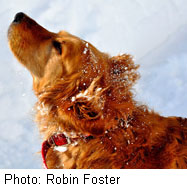- Skip Storing This Everyday Product in the Fridge Door
- Green Tea + B3 Pairing May Boost Brain Health
- Navigating Your Midlife Crisis: Embracing New Possibilities
- City Raccoons Showing Signs of Domestication
- Mapping the Exposome: Science Broadens Focus to Environmental Disease Triggers
- One Week Less on Social Media Linked to Better Mental Health
- Your Brain Changes in Stages as You Age, Study Finds
- Some Suicide Victims Show No Typical Warning Signs, Study Finds
- ByHeart Formula Faces Lawsuits After Babies Sickened With Botulism
- Switch to Vegan Diet Could Cut Your Greenhouse Gas Emissions in Half
Your Dog Truly Loves Your Scent


Your scent may affect your dog’s brain in the same way a fragrance used by a loved one triggers a reaction in you, according to a new study.
Learning more about how dogs’ brains work could improve selection and training of service dogs, the researchers said.
They conducted brain scans of 12 dogs of various breeds while the dogs were presented with five different scents. The scent samples were from the dog itself, an unfamiliar dog, a dog that lived in the same home, an unfamiliar person and a person that lived in the dog’s home.
The results showed that a reward area in the dogs’ brains responded more strongly to the scents of familiar people than to the scents of other people or even of familiar dogs.
“It’s one thing when you come home and your dog sees you and jumps on you and licks you and knows that good things are about to happen,” study leader Gregory Berns, director of the Center for Neuropolicy at Emory University, said in a university news release.
“In our experiment, however, the scent donors were not physically present,” he said. “That means the canine brain responses were being triggered by something distant in space and time. It shows that dogs’ brains have these mental representations of us that persist when we’re not there.”
Berns noted that people often have an immediate and emotional reaction when they smell the perfume or cologne of someone they love.
“Our experiment may be showing the same process in dogs,” he said. “But since dogs are so much more olfactory than humans, their responses would likely be even more powerful than the ones we might have.”
The study, which was published online recently in the journal Behavioural Processes, is thought to be the first to use brain scans to examine the response of dogs to biological odors.
“We plan to do further research to determine whether we can use brain-imaging techniques to better identify dogs that are optimal to serve as companion animals for the disabled,” Berns said.
He noted that training service dogs is time-consuming and costly, and only about one-third of dogs that begin the training complete it. Waiting lists for service dogs are long, and many people on those waiting lists are wounded veterans.
“In addition to serving as companion animals for wounded veterans, dogs play many important roles in military operations,” Berns said. “By understanding how dogs’ brains work, we hope to find better methods to select and train them for these roles.”
More information
The American Society for the Prevention of Cruelty to Animals explains dog behavior.
Source: HealthDay
Copyright © 2025 HealthDay. All rights reserved.










